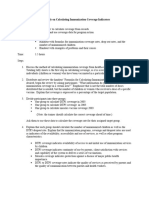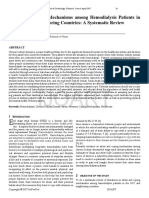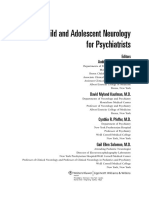Handout 5 2.4a
Handout 5 2.4a
Uploaded by
tegenatalayCopyright:
Available Formats
Handout 5 2.4a
Handout 5 2.4a
Uploaded by
tegenatalayOriginal Title
Copyright
Available Formats
Share this document
Did you find this document useful?
Is this content inappropriate?
Report this DocumentCopyright:
Available Formats
Handout 5 2.4a
Handout 5 2.4a
Uploaded by
tegenatalayCopyright:
Available Formats
The complete RHIS curriculum is available here:
5.2.4
CALCULATING IMMUNIZATION COVERAGE
INDICATORS
Exercise on Practicing Data Analysis, Step 2
Instructions
For immunization programs (see Excel file Handout 5.2.4b), coverage and dropout rates are used as
indicators of the availability, accessibility, and use of services, as well as other program
characteristics.
Penta1 coverage indicates availability of access to and initial use of immunization
services by children.
Penta3 coverage indicates continuity of use by parents, client satisfaction with
services, and capacity of the system to deliver a series of vaccinations.
Penta1 to Penta3 dropout rates indicate the quality of services as perceived by parents
and the quality of communication between parents and health workers.
1. Calculate the following:
a. Penta1 coverage rate in 2014
b. Penta3 coverage rate in 2014
c. Penta1–Penta3 dropout rate in 2014
2. Specify in column “N” the quality of access (good or poor) depending on the value of the DTP1
coverage (“good” is defined, in this exercise, as Penta1 coverage >=80% in the target age group,
and “poor” corresponds to a Penta1 coverage in the target age group < 80%).
3. Specify in column “O” the quality of utilization (good or poor) depending on the value of the
dropout rate (“good” is defined, in this exercise, as a dropout rate in the target age group < 10%,
and “poor” corresponds to a dropout rate in the target age group >=10%).
4. Categorize the problem present in each area in 2014. There are four situations:
1: No problem Dropout rates are low = good utilization
Penta1 coverage is high = good access
2: Problem Dropout rates are high = poor utilization
Penta1 coverage is high = good access
3: Problem Dropout rates are low = good utilization
Penta1 coverage is low = poor access
4: Problem Dropout rates are high = poor utilization
Penta1 coverage is low = poor access
5. The next step is to decide the area (listed in column “a”) that should receive top priority when
starting to implement the identified solutions. Participants should complete column “P,” writing
the order of priority (i.e., the number of the problem category: 1, 2, 3, or 4).
6. Upon completion of calculations, as a group, brainstorm about the differences in coverage
between regions and possible causes. Discuss what action managers can take if coverage and
dropout indicate problems.
Formulas for Calculating Immunization Coverage from Health Facility Data
Routine coverage estimates are calculated using statistics collected by health workers.
Penta1 coverage = Number immunized by 12 months with Penta1 in 2014 x 100
Number of surviving infants < 12 months of age in 2014
Penta3 coverage = Number immunized by 12 months with Penta3 in 2014 x 100
Number of surviving infants < 12 months of age in 2014
Penta1-Penta3 dropout rate Doses of Penta1 administered – Doses of Penta3 administered x 100
=
Doses of Penta1 administered
Identifying Problems and Their Possible Causes
Problems Possible Causes of Problems
Parents do not bring children in for 1. Health workers have not clearly explained to parents what
additional immunizations (utilization vaccinations are due, when they are due, and why they are needed.
problem). 2. Health workers do not understand what vaccinations are due, when
they are due, and why they are needed.
3. Barriers discourage parental return (e.g., hours of clinic operation,
cost, and long waits).
4. Health workers do not clearly explain to parents when vaccinations
are administered at the clinic.
5. Health workers have not shown parents respect or conveyed an
interest in the child’s health.
Children and mothers are not immunized 1. Health workers forget to check records or ask about what vaccines
when coming to the clinic for sick visits and doses a child/mother has received.
(utilization problem). 2. Health workers do not understand the contraindications for
immunizations or health workers do not understand that
immunizations may be given to mildly ill children.
3. Health workers fail to explain to parents that it is often acceptable to
immunize a mildly ill child.
4. Immunizations are not available on that day.
5. Immunization supplies are not available.
Health workers cannot determine what 1. Health workers forget to remind parents to bring the immunization
immunizations a child has received card.
(utilization problem). 2. Clinic records are not organized so that it is easy to find a child’s
records.
Children are not receiving all vaccines 1. Health workers do not understand what vaccinations are due, when
that they are eligible to receive during a they are due, and why they are needed.
visit (utilization problem). 2. All immunizations are not available or offered at the clinic on the
same day.
3. Supplies of some immunizations are not sufficient.
Children never come to the clinic to begin 1. The clinic is located too far away.
immunization (access problem). 2. Clinic hours are not convenient or are not understood by the
community.
3. Outreach activities are too infrequent, or their timing is not
understood by the community.
4. Cultural, financial, racial, gender, or other barriers are preventing use
of immunization services.
Adapted from World Health Organization (WHO). (2002). Increasing immunization coverage at the health facility level. Geneva,
Switzerland: WHO. Retrieved from http://apps.who.int/iris/handle/10665/67791
You might also like
- UVU NOVICE DIGITAL Ahj4Document130 pagesUVU NOVICE DIGITAL Ahj4dawidoffvs100% (2)
- Test Bank - & Women's Health Across The Lifespan, 11th Edition (Davidson), Chapters 1 - 36 - All Chapters VerifiedDocument51 pagesTest Bank - & Women's Health Across The Lifespan, 11th Edition (Davidson), Chapters 1 - 36 - All Chapters Verifiedkevinkariuki227No ratings yet
- Manual Imw 50 2500Document177 pagesManual Imw 50 2500Jose100% (2)
- Table 5 Sample Family Nursing Care PlanDocument3 pagesTable 5 Sample Family Nursing Care Plandave_castañeda86% (78)
- Nursing Assistant A Nursing Process Approach 11Th Edition Acello Solutions Manual Full Chapter PDFDocument67 pagesNursing Assistant A Nursing Process Approach 11Th Edition Acello Solutions Manual Full Chapter PDFhelgasophie7478k0100% (12)
- Animal NutritionDocument9 pagesAnimal NutritionYasir MehmoodNo ratings yet
- Ball & Bindler Pediatric Nursing - Caring For ChildrenDocument105 pagesBall & Bindler Pediatric Nursing - Caring For Childrenfriendofnurse50% (4)
- Test Bank For Child Health Nursing 3rd Edition Jane W BallDocument19 pagesTest Bank For Child Health Nursing 3rd Edition Jane W BallClifton Aslam100% (38)
- CoDA Tools of RecoveryDocument6 pagesCoDA Tools of RecoveryASBseNo ratings yet
- Sample Curriculum Map For NCM 109Document9 pagesSample Curriculum Map For NCM 109Nina Anne Paracad100% (4)
- Ayurveda Tongue Analysis Dr. Rama PrasadDocument34 pagesAyurveda Tongue Analysis Dr. Rama PrasadSanjay Soni100% (2)
- Case Study1 - Calculating Coverage IndicatorsDocument4 pagesCase Study1 - Calculating Coverage IndicatorstegenatalayNo ratings yet
- UntitledDocument6 pagesUntitledAnna YepisNo ratings yet
- Reading VaccineImmunizationDocument13 pagesReading VaccineImmunizationelztly4694No ratings yet
- Test Bank For Lemone and Burkes Medical Surgical Nursing 7th by BauldoffDocument48 pagesTest Bank For Lemone and Burkes Medical Surgical Nursing 7th by Bauldoffrobertrichardsonjxacntmdqf100% (35)
- OSPHE PrepDocument30 pagesOSPHE PrepChristopher SeerajNo ratings yet
- BFB 8Document20 pagesBFB 8Rubina MasihNo ratings yet
- MODULE 3 Formative Assessment BDocument1 pageMODULE 3 Formative Assessment Bms. nobodyNo ratings yet
- FeDocument7 pagesFeWilfredo PesanteNo ratings yet
- Test Bank Medical Surgical Nursing Clinical Reasoning in Patient Care 6th Lemone Burke Bauldoff GubrudDocument60 pagesTest Bank Medical Surgical Nursing Clinical Reasoning in Patient Care 6th Lemone Burke Bauldoff GubrudMichaelBlairozrc100% (33)
- Super Final Research 2 - ULS MANE ThesisDocument68 pagesSuper Final Research 2 - ULS MANE ThesisEden NatividadNo ratings yet
- Notre Dame of Tacurong College College of Nursing: Questions: 1Document5 pagesNotre Dame of Tacurong College College of Nursing: Questions: 1Hanz Alecz Q. DasmariñasNo ratings yet
- Full Download PDF of Test Bank For Contemporary Medical Surgical Nursing, 2nd Edition: Daniels All ChapterDocument27 pagesFull Download PDF of Test Bank For Contemporary Medical Surgical Nursing, 2nd Edition: Daniels All Chaptervassouyunin100% (8)
- Olds Maternal Newborn Nursing and Womens Health Across The Lifespan Davidson 9th Edition Test BankDocument29 pagesOlds Maternal Newborn Nursing and Womens Health Across The Lifespan Davidson 9th Edition Test BankBrent Theiler100% (37)
- Full Download Nursing Assistant A Nursing Process Approach 11th Edition Acello Solutions Manual All Chapter 2024 PDFDocument44 pagesFull Download Nursing Assistant A Nursing Process Approach 11th Edition Acello Solutions Manual All Chapter 2024 PDFemvulaoisin1100% (10)
- Instant Download PDF Nursing Assistant A Nursing Process Approach 11th Edition Acello Solutions Manual Full ChapterDocument72 pagesInstant Download PDF Nursing Assistant A Nursing Process Approach 11th Edition Acello Solutions Manual Full Chaptertroldjurjen100% (11)
- Nursing Assistant A Nursing Process Approach 11th Edition Acello Solutions Manual Instant Download All ChapterDocument72 pagesNursing Assistant A Nursing Process Approach 11th Edition Acello Solutions Manual Instant Download All Chaptersaikijrz100% (8)
- COVID19 Healthcare Tabletop FacilitatorDocument26 pagesCOVID19 Healthcare Tabletop FacilitatorDragomir MariusNo ratings yet
- A Study To Evaluate The Efficacy of Self Instructional Module (SIM) On Knowledge and Practice Regarding Newborn Care Among Staff Nurses Working in Selected Hospitals of Delhi NCRDocument6 pagesA Study To Evaluate The Efficacy of Self Instructional Module (SIM) On Knowledge and Practice Regarding Newborn Care Among Staff Nurses Working in Selected Hospitals of Delhi NCRInternational Organization of Scientific Research (IOSR)No ratings yet
- Awareness Among Mothers Regarding Care of Child During Primary Immunization - An Interventional Studyin Selected Health Facility of Himachal PradeshDocument6 pagesAwareness Among Mothers Regarding Care of Child During Primary Immunization - An Interventional Studyin Selected Health Facility of Himachal PradeshIJAR JOURNALNo ratings yet
- Knowledge, Attitude and Practice of Mothers Toward Children's Obligatory VaccinationDocument7 pagesKnowledge, Attitude and Practice of Mothers Toward Children's Obligatory VaccinationkrishnasreeNo ratings yet
- Critical Appraisal RCT B.ingDocument3 pagesCritical Appraisal RCT B.ingﺳﻮﺘﻴﺎﺳﻴﻪNo ratings yet
- Assignment 1: NCLEX Question Design Eugenia Long NURS 603 Dr. Kirsty Digger April 5, 2018Document16 pagesAssignment 1: NCLEX Question Design Eugenia Long NURS 603 Dr. Kirsty Digger April 5, 2018api-384606877No ratings yet
- Syllabus NCM 109 Care of Mother Child Adolescent at Risk or With ProblemDocument37 pagesSyllabus NCM 109 Care of Mother Child Adolescent at Risk or With Problembrilliant dumay100% (1)
- International Journal of Trend in Scientific Research and Development (IJTSRD)Document8 pagesInternational Journal of Trend in Scientific Research and Development (IJTSRD)Editor IJTSRDNo ratings yet
- Test Bank MTDocument398 pagesTest Bank MTjanmishelle208100% (2)
- Antibiotic Targets SlidesDocument20 pagesAntibiotic Targets SlidesGuissella JesúsNo ratings yet
- PediatricsDocument10 pagesPediatricsapi-253312159No ratings yet
- Framework For Maternal and Child Health NursingDocument7 pagesFramework For Maternal and Child Health NursingBeBs jai SelasorNo ratings yet
- Silvestri001100Document55 pagesSilvestri001100lilchibaby100% (1)
- Medical Surgical Nursing Care 4th Edition Burke Solutions Manual Full DownloadDocument10 pagesMedical Surgical Nursing Care 4th Edition Burke Solutions Manual Full Downloadvictoriamartinezwtmqzdsgbc100% (46)
- Nursing Action PlanDocument9 pagesNursing Action PlanMatthew LeeNo ratings yet
- Forbat 2017Document8 pagesForbat 2017anggiavioNo ratings yet
- Nur 318 Ob Clinical AssignmentDocument49 pagesNur 318 Ob Clinical AssignmentGina FasoloNo ratings yet
- Week 7. 2 CHN-FNCPDocument51 pagesWeek 7. 2 CHN-FNCPPatrick Jumao-asNo ratings yet
- Tren Kesalahan Pengobatan Dan Efek Dari Faktor Yang Berhubungan Dengan Orang, Terkait Lingkungan Dan Komunikasi Pada Kesalahan Pengobatan Di Rumah Sakit AnakDocument7 pagesTren Kesalahan Pengobatan Dan Efek Dari Faktor Yang Berhubungan Dengan Orang, Terkait Lingkungan Dan Komunikasi Pada Kesalahan Pengobatan Di Rumah Sakit AnakEnggar Ardiani TagapNo ratings yet
- PRS Ob WardDocument5 pagesPRS Ob WardEmmanuel BillenaNo ratings yet
- Vargis Eval GoodDocument3 pagesVargis Eval Goodapi-681331537No ratings yet
- Clinical Skills For Pharmacists A Patient Focused Approach PDF 17420717Document14 pagesClinical Skills For Pharmacists A Patient Focused Approach PDF 17420717John LópezNo ratings yet
- Taking Medication HisotoriesDocument14 pagesTaking Medication HisotoriesCésar Augusto Sánchez SolisNo ratings yet
- Content of The NclexDocument8 pagesContent of The NclexHerkulanus ErwinNo ratings yet
- Maternal and Child Health NursingDocument11 pagesMaternal and Child Health NursingNoelle FabrosNo ratings yet
- Intro NclexDocument10 pagesIntro NclexMicca ClarinNo ratings yet
- Child Health Nursing Partnering With Children and Families 3rd Edition Ball Test BankDocument15 pagesChild Health Nursing Partnering With Children and Families 3rd Edition Ball Test Bankkevinfryecqiozexkjy100% (31)
- CHN1 Lec Session #19 SASDocument9 pagesCHN1 Lec Session #19 SASMark Raymunstine TamposNo ratings yet
- A Postpartum Vaccination PromotionDocument8 pagesA Postpartum Vaccination Promotionanon_327352238No ratings yet
- 10 1016@j Accpm 2019 10 019Document6 pages10 1016@j Accpm 2019 10 019Sri NingsihNo ratings yet
- SURVEY QUESTIONNAIRE FinalizeDocument8 pagesSURVEY QUESTIONNAIRE FinalizeJENNY BUTENo ratings yet
- Barangay Putik (Report)Document26 pagesBarangay Putik (Report)Shareen AbdusalamNo ratings yet
- PDF Test Bank For Basic Nursing by Treas Online Ebook Full ChapterDocument32 pagesPDF Test Bank For Basic Nursing by Treas Online Ebook Full Chapterjay.gosch788100% (8)
- Test Bank For Nursing Leadership and Management For Patient Safety and Quality Care 1st EditionDocument33 pagesTest Bank For Nursing Leadership and Management For Patient Safety and Quality Care 1st Editionqytetmizba81No ratings yet
- Care PlanDocument4 pagesCare Planapi-217086261No ratings yet
- The Maximally Efficient and Optimally Effective Emergency Department: One Good Thing A DayFrom EverandThe Maximally Efficient and Optimally Effective Emergency Department: One Good Thing A DayNo ratings yet
- Hand PosturesDocument6 pagesHand Posturesmadream7No ratings yet
- FoodForYou2 PDFDocument272 pagesFoodForYou2 PDFNura YekravNo ratings yet
- ISMA/Anthem Compliance Dispute Questions & AnswersDocument6 pagesISMA/Anthem Compliance Dispute Questions & AnswersSonam ChandNo ratings yet
- Infective Vegetative Endocarditis of The Mitral, Aortic, and Pulmonary Valves Due To Enterococcus Hirae in A Cat With A Ventricular Septal DefectDocument26 pagesInfective Vegetative Endocarditis of The Mitral, Aortic, and Pulmonary Valves Due To Enterococcus Hirae in A Cat With A Ventricular Septal DefectAna AldazNo ratings yet
- Pastoral Letter - RH Bill - Antonio J. Ledesma S.JDocument6 pagesPastoral Letter - RH Bill - Antonio J. Ledesma S.JCBCP for LifeNo ratings yet
- Stress and Coping Mechanisms Among Hemodialysis Patients in The Gulf and Neighboring Countries A Systematic ReviewDocument5 pagesStress and Coping Mechanisms Among Hemodialysis Patients in The Gulf and Neighboring Countries A Systematic ReviewMahalakshmiNo ratings yet
- Bhanu - Medical 4Document1 pageBhanu - Medical 4Shanthi Sandeep GanjiNo ratings yet
- 66kV Connection Guide - Version 7Document43 pages66kV Connection Guide - Version 7Ajay Dixit100% (1)
- Responsible Parenthood and Reproductive Health Report of Accomplishment For October To December 2020 Kra: Maternal HealthDocument13 pagesResponsible Parenthood and Reproductive Health Report of Accomplishment For October To December 2020 Kra: Maternal HealthGamu DILGNo ratings yet
- C CDocument2 pagesC Capi-354302626No ratings yet
- Food MattersDocument4 pagesFood Mattersapi-254020111No ratings yet
- Whitepaper Changes IEC 61496 en IM0051633Document8 pagesWhitepaper Changes IEC 61496 en IM0051633Cláudio ZimmerNo ratings yet
- Child and Adolescent Neurology For Psychiatrists: Editors Audrey M. Walker, M.DDocument447 pagesChild and Adolescent Neurology For Psychiatrists: Editors Audrey M. Walker, M.DLolitha Sánchez100% (1)
- Mlvss Mlss RatioDocument7 pagesMlvss Mlss RatiocassindromeNo ratings yet
- Gestalt Group ProcessDocument10 pagesGestalt Group ProcessResidencia de Psicologia100% (1)
- SaudiJHealthSci4142-1740933 045009Document9 pagesSaudiJHealthSci4142-1740933 045009Ramona BordeaNo ratings yet
- PLUMBING-TERMINOLOGIESDocument181 pagesPLUMBING-TERMINOLOGIESShe Lied100% (2)
- Foxconn HR ProblemsDocument21 pagesFoxconn HR ProblemsvothongtuNo ratings yet
- Contoh Soal B InggrisDocument7 pagesContoh Soal B InggrisEli SuhaeliNo ratings yet
- Gender Equality As A Tool For Sustainable DevelopmentDocument3 pagesGender Equality As A Tool For Sustainable DevelopmentIJELS Research JournalNo ratings yet
- DepEd Minimum Health StandardsDocument33 pagesDepEd Minimum Health StandardsRyan Q. BlancoNo ratings yet
- Syllabus: M. Sc. General BiotechnologyDocument45 pagesSyllabus: M. Sc. General Biotechnologychicklit subliminalNo ratings yet
- Airofit PRO Quick GuideDocument29 pagesAirofit PRO Quick GuideDracones Di Paolo DragoniNo ratings yet
- Planned Parenthood's Motion/Memorandum For Preliminary InjunctionDocument190 pagesPlanned Parenthood's Motion/Memorandum For Preliminary InjunctionThe Salt Lake TribuneNo ratings yet
- Asia Pacific College of Advanced STUDIES StudiesDocument2 pagesAsia Pacific College of Advanced STUDIES StudiesLore Anne Mhae SantosNo ratings yet
- Urinalysis OSCE GuideDocument5 pagesUrinalysis OSCE GuideSSNo ratings yet

























































































